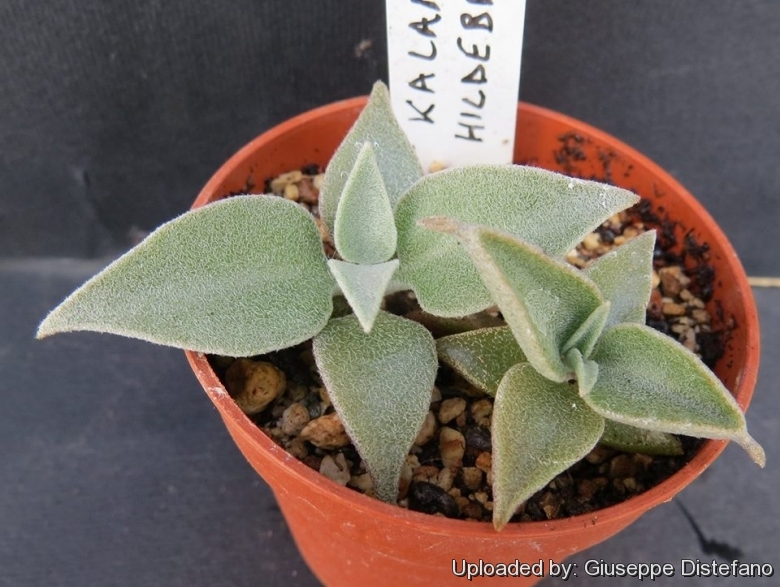
Kalanchoe hildebrandtii Photo by: Giuseppe Distefano
Origin and Habitat: Southern and south-western Madagascar.
Habitat and ecology: Xerophytic bush on various soils and rocks.
Synonyms:
See all synonyms of Kalanchoe hildebrandtii
back
Accepted name in llifle Database:Kalanchoe hildebrandtii Baill.Bull. Mens. Soc. Linn. Paris 1: 468 1882Synonymy: 3
back
Common Names include:
ENGLISH: Silver Teaspoon
Description: Known as "Silver Teaspoons", Kalanchoe hildebrandtiiSN|30170]]SN|30170]], is a shrubby succulent plant with lovely smooth silver-grey leaves. It is rather similar in vegetative growth and is closely related to Kalanchoe bracteataSN|30170]]SN|32127]] which grows in the same locality, but has white flowers that are not as attractive by any means as the red ones of Kalanchoe bracteataSN|32127]]SN|32127]]. Kalanchoe hildebrandtiiSN|32127]]SN|30170]] is a woody species of very slow growth. In its native habitat in Central Madagascar, it attains the proportions of a small tree, often surpassing 5 meters. A glabrous variety (Kalanchoe hildebrandtiiSN|30170]]SN|30170]] var. glabra), here tentatively placed as synonym, appears to fall within the natural variation.
Stems: Woody, erect, strongly branched.
Leaves; Entire, lamina thick, tough, circular to obovate, obtuse, 16-40(-50) mm long, 15-20(-35) mm wide, tip obtuse to rounded, base suddenly cuneate, margins entire, glaucous grey green to greenish, covered by dense minute stellate hairs (with 3 bifid or multifid branches), hairs very appre ssed and giving the plants a glabrous appearance. Petiole cylindrical, canaliculate, 3-8 mm long.
Inflorescence: Dense cymes arranged in panicles 8-35 cm long. Flowers more or less erect. Pedicels 1.5-4 mm long.
Flowers: Very small, in Winter, fleshy, bell-shaped, white to pale greenish yellow. Calyx green, tube c. 0.5 mm, sepals deltoid, acute, 1.2-2.5 mm long and wide. Corolla white, pale green to yellow, urceolate, sparingly hairy, tube 3 - 5 mm long. Lobes oblong-acute, ovate, obtuse, 2-3.5 mm long, 1.5-2 mm wide. Stamens incIuded or slightly exserted, anthers and styles projecting. Filaments free for 1.5-3.5 mm.
Chromosome number: 2n = 36
Bibliography: Major references and further lectures
1) James Cullen, Sabina G. Knees, H. Suzanne Cubey “The European Garden Flora Flowering Plants:A Manual for the Identification of Plants Cultivated in Europe, Both Out-of-Doors and Under Glass” Cambridge University Press, 11/August/2011
2) Werner Rauh “The Wonderful World of Succulents: Cultivation and Description of Selected Succulent Plants Other Than Cacti” Smithsonian Institution Press, 1984
3) Hermann Jacobsen “A handbook of succulent plants: descriptions, synonyms, and cultural details for succulents other than Cactaceae, Volume 1” Blandford Press, 1960
4) Eggli, U. "The Illustrated Handbook of Succulent Plants; Crassulaceae." Berlin: Springer-Verlag. 2003
5) Kalanchoe hildebrandtii in: The American Horticultural Magazine, Volumes 33-34 page 226-233 1954.
6) Hamet R. & Marnier-Lapostolle J. “Le genre. Kalanchoë au jardin botanique 'Les Cèdres'”. Arch. Mus. Natn. Hist. Nat. 8: 1–107 1964.
7) Kalanchoe hildebrandtii in: International Crassulaceae Network <http://www.crassulaceae.ch> Web. 13 Jan. 2015.
Cultivation and Propagation: Kalanchoe hildebrandtiiSN|30170]]SN|30170]] is a beautiful succulent, which grows very quickly and easily with little care. Excellent in the garden or as a feature plant in a container.
Potting mix: They thrive in nutrient porous soils consisting of equal parts of loam and sand, with pumice or lava grit added to ensure good drainage.
Repotting: Repot them in Autumn and left outside in a bright but cool and dry location until first frost. The cool temperature along with the shorter days at the back of the Solarium where the light levels are relatively low stimulate the production of abundant flower buds.
Hardiness: Kalanchoe hildebrandtiiSN|30170]]SN|30170]] isn't hardy to severe freeze, but seem to tolerate everything else. It need to be covered at least and housed in cold climates.
Exposure: Plant in full sun to partial shade, but will grow in pretty deep shade without much trouble.
Salt Tolerance: Medium.
Uses: It makes a nice landscape plant in warmer climates because it does not require much maintenance. In colder climates, it can be grown as outdoor pot plant in summer and a nice indoor accent plant in winter.
Propagation: It is propagated by removal of small offsets at the base of the main plant or by leaf and stem cuttings. It grows easily roots at the end of a leaf stalk which has fallen onto ground. New plants are ready within months.










